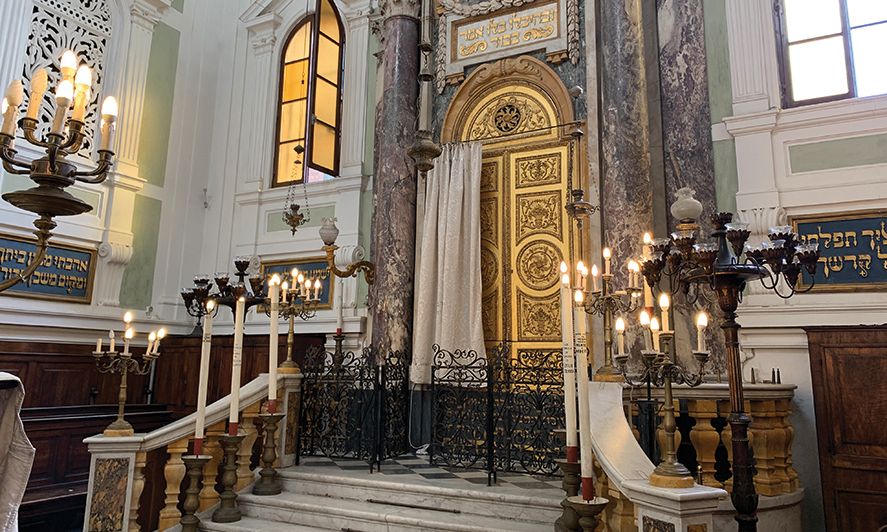The synagogue, designed by Giuseppe del Rosso in 1786, attracts thousands of visitors every year Opera Laboratori
Florence’s Jewish community has raised hundreds of thousands of euros to save an 18th-century synagogue in Siena after an earthquake damaged the building last year.
Designed by the Florentine architect Giuseppe del Rosso in 1786, the synagogue’s Neo-Classical interior is embellished with Rococo decorations and contains numerous ritual artefacts, including a carved chair of Elijah and smaller objects conserved in a Torah ark chamber flanked with marble columns. Memorial plaques bear witness to centuries of persecution: the anti-Jewish pogrom of 1799 and the deportations to Nazi death camps in 1943. The building functions as a ticketed museum, attracting thousands of visitors every year, though it also hosts occasional religious services, making it one of Europe’s few remaining pre-19th century Jewish synagogues still used for worship.
A 3.5 magnitude earthquake hit Siena in February 2023, pushing ceiling beams in adjoining buildings sideways and making the synagogue’s vault and roof unstable. The entrance was roped off, meaning visitors could peer inside the prayer room but could not enter it, while religious services had to be moved to the Women’s Gallery on the first floor.
With the restoration expected to cost €368,000, the Jewish Community of Florence—a religious organisation that administers the synagogues of Florence, Siena and Monte San Savino—launched a fundraising campaign in September. Ninety percent of the funds had been raised by early May, with grants from the Leon Levy Foundation and the David Berg Foundation, and contributions from the Misericordia Israelitica di Siena and the Fondazione Beni Culturali Ebraici in Italia.
In April, the synagogue was placed on this year’s 7 Most Endangered monuments and heritage sites in Europe list, a joint initiative from the pan-European cultural heritage federation Europa Nostra and the European Investment Bank (EIB) Institute. The resulting visibility helped drive donations for the repairs, Brett Lalonde, the vice president of the Jewish Community of Florence, tells The Art Newspaper. “It really boosted awareness of this site,” she says.
Restoration work started in May and is expected to take three months to complete. Experts will first stabilise the vault before repairing the building’s roof and returning its Neo-Classical decorations to their original splendour.
Many other Jewish heritage sites across Italy are also at risk. The country’s Jewish population has diminished to around 28,000 from 47,000 in 1938, and synagogues have been demolished, deconsecrated, converted into churches, turned into museums or fallen into disrepair.
Anna Di Castro, the archivist of the Jewish Community of Florence, estimates that only around 20 synagogues today retain their original religious functions. Many more are open to visitors.
For the past eight years, the Jewish Cultural Heritage Foundation in Italy (FBCEI) has been cataloguing Jewish heritage sites and their state of conservation. Dario Disegni, president of the FBCEI, says urgent restoration is required for numerous Jewish cemeteries—including an ancient burial site in Gorizia, where the oldest tombstone dates from 1371—as well as synagogues like the one in Chieri, now a deconsecrated, privately owned building that the city council is trying to purchase and restore to the Jewish community. He estimates the restoration would cost €800,000 and suggests that the site could be turned into a museum.
Disegni says Italy’s culture ministry is considering reactivating a regular budget, previously active from 2005 to 2009, for conserving and restoring Jewish heritage. He says the ministry has recently committed generous funds to creating two new Jewish museums—in Rome and Milan—and has pledged to provide €2.5m for the restoration of parts of Venice’s Jewish Ghetto.
Even so, individual Jewish communities usually bear the burden of raising restoration funds. Last March, just weeks after the Siena earthquake, regular maintenance of Florence’s synagogue uncovered structural problems with the building’s façade due to wear and tear. The Jewish Community of Florence raised €88,000 in private donations and through crowdfunding, and restored the building, inaugurating it in April. The visibility provided to the Siena project by the 7 Most Endangered programme could also make it easier to fund future projects in Florence, Lalonde predicts.
The Siena synagogue “looked like a case to be taken right now,” says Guy Clausse, the executive vice-president of Europa Nostra and a former dean of the EIB Institute. “Either you act quickly or you will need to do more restoration work in the future.”

